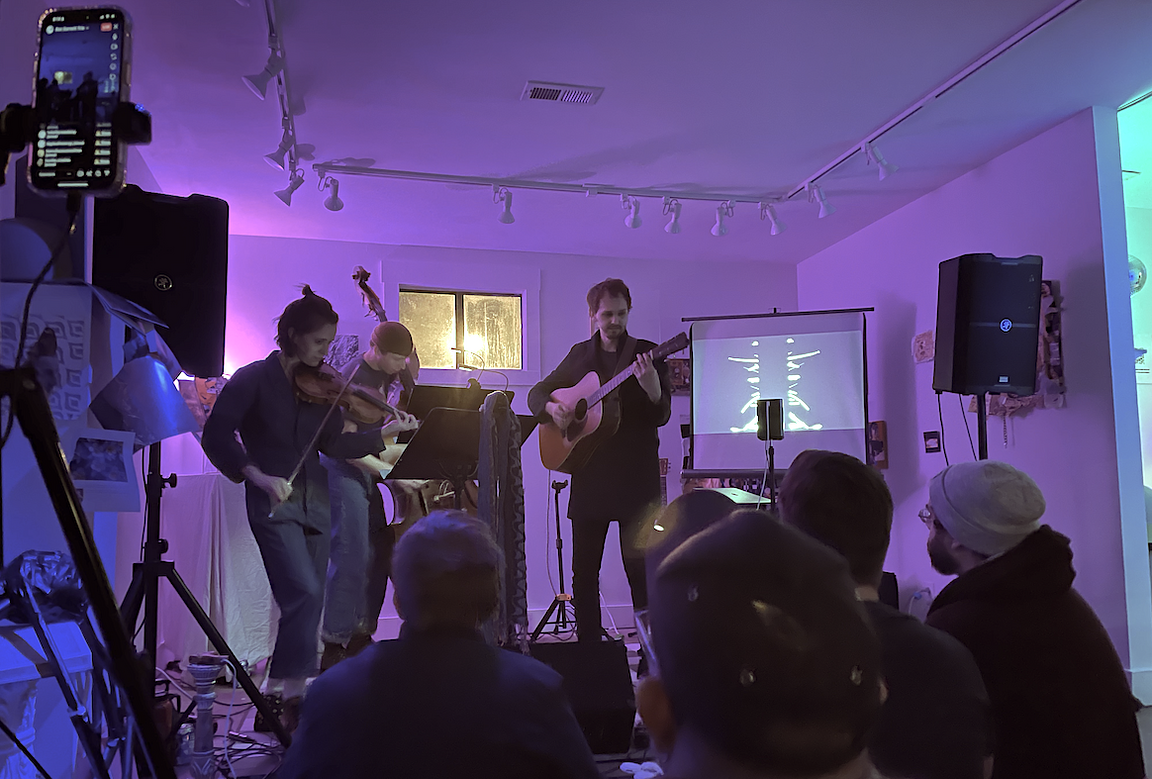Ben Garnett
Random Sample
Nashville, TN
Jan. 12, 2024
If my videos and photos make it look like I’m sitting on the floor behind, underneath, or inside a camera tripod in a room smaller than most living rooms and almost in a stranger’s lap, it’s because I was. The spot was West Nashville’s teeny-tiny DIY spot Random Sample.
On Friday night, anyone who could physically fit inside got the pleasure of seeing three musicians who typically play for audiences of hundreds, sometimes thousands, perform Ben Garnett’s original compositions from his in-the-making sophomore album.
Garnett, who tours with legendary bass player Missy Raines, brought quite the band out to play down his currently unrecorded album. The combination of Brittany Haas (The Punch Brothers, Dave Rawlings Machine, Hawktail) on fiddle, Eli Broxham (The Arcadian Wild, Dallas Ugly) on upright bass, and Garnett on acoustic guitar spellbound the audience with an experience that was simultaneously intimate in delivery but sonically expansive for the entirety of the 45-minute program.
The music was entirely instrumental, in the category of “new acoustic” — a style developed in the late ’90s by musicians such as Yo-Yo Ma and Mark O’Connor that fuses various acoustic folk styles with a classical compositional approach and execution. Garnett, who flatpicked the whole program, clearly pulled from his background in both jazz and bluegrass in his compositions, while also incorporating textures found in contemporary classical music. The latter was largely done through the use of form and extended technique. At times Broxham, for example, used the body of his bass as a percussive instrument to create a soundscape rather than provide any rhythmic information, while Haas did the same with her bow.
Even though the trio read from sheet music, which can sometimes be limiting, the serious nonverbal communication among the musicians made the performance very engaging, visually and otherwise. During the first tune, Haas had her eyes glued to Broxham’s bow, and the trio moved as a unit as they conversed with their instruments throughout every piece. I would be very interested to see Garnett’s notation, as the players were clearly given a lot of freedom even within the heavily structured confines of the music: each player’s individual voice was clear and present in both their melodic and accompaniment playing, and it at least seemed as though there were many moments of improvisation.
Haas, who has singlehandedly pioneered an entire approach to the fiddle that droves of musicians now try to imitate, added a lot to the performance with her stunning phrasing sensibilities and a constant undercurrent of groove in her playing. She shaped Garnett’s melodies into the best versions of themselves. Observing how she used her bow up close was one of the biggest highlights for me, personally. Garnett moved with ease between feathery and thoughtful solos, driving the bus with his bluegrass-style rhythm and executing virtuosic passages. Broxham blended into the trio seamlessly, supporting the two lead players as a bass should, while also demonstrating his extensive skill on the instrument and versatility with the bow.
Random Sample at its core is a fabulous space, but the lack of ventilation in such close quarters was such that I left immediately after the performance was done even in the winter. It’s not a venue for the faint of heart or the elderly. But it needs to exist in Nashville, and is the perfect setting for an unamplified ensemble and art pieces like Garnett’s work. Garnett’s trio performance demonstrated the bounds (or lack thereof?) of folk music as a form of high art. The setting played a similar role with its unconventional intimacy and steadfast commitment to being a space where anything can happen.





